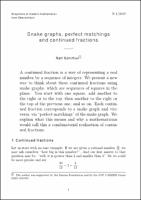| dc.contributor.author | Schiffler, Ralf | |
| dc.contributor.editor | Munday, Sara | |
| dc.contributor.editor | Cederbaum, Carla | |
| dc.date.accessioned | 2019-02-13T09:57:05Z | |
| dc.date.available | 2019-02-13T09:57:05Z | |
| dc.date.issued | 2019-02-13 | |
| dc.identifier.uri | http://publications.mfo.de/handle/mfo/1405 | |
| dc.description.abstract | A continued fraction is a way of representing a real
number by a sequence of integers. We present a new
way to think about these continued fractions using
snake graphs, which are sequences of squares in the
plane. You start with one square, add another to
the right or to the top, then another to the right or
the top of the previous one, and so on. Each continued
fraction corresponds to a snake graph and vice
versa, via “perfect matchings” of the snake graph. We
explain what this means and why a mathematician
would call this a combinatorial realization of continued
fractions. | en_US |
| dc.language.iso | en | en_US |
| dc.publisher | Mathematisches Forschungsinstitut Oberwolfach | en_US |
| dc.relation.ispartofseries | Snapshots of modern mathematics from Oberwolfach;2019,01 | |
| dc.rights | Attribution-NoDerivatives 4.0 International | * |
| dc.rights.uri | http://creativecommons.org/licenses/by-nd/4.0/ | * |
| dc.title | Snake graphs, perfect matchings and continued fractions | en_US |
| dc.type | Article | en_US |
| dc.identifier.doi | 10.14760/SNAP-2019-001-EN | |
| local.series.id | SNAP-2019-001-EN | en_US |
| local.subject.snapshot | Algebra and Number Theory | en_US |
| local.subject.snapshot | Discrete Mathematics and Foundations | en_US |
| dc.identifier.urn | urn:nbn:de:101:1-2019022712125053523984 | |
| dc.identifier.ppn | 1655533916 | |


